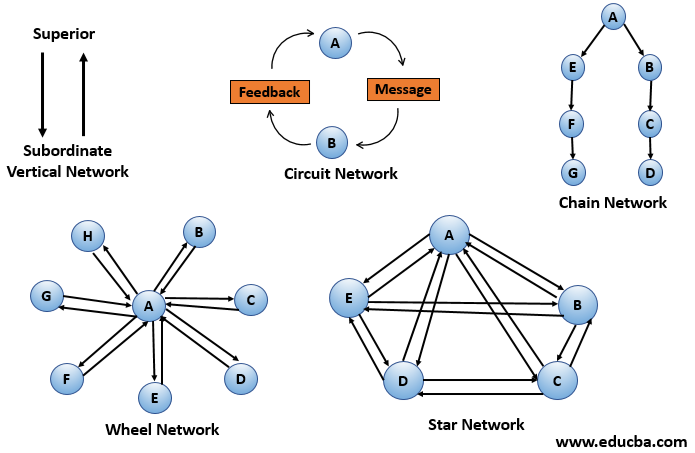Updated July 28, 2023

Introduction to Communication Network
In this article, we will see an outline on Types of Communication Network. In an organization, members contact each other and the pattern of contacts or flow of information is the communication network. Contacts are created with different pattern and this helps the management to contact the employees. Through the network, the resources can share their data and applications. The network is divided based on the number of people involved in the communication, organizational size and nature of the communication network. The common network patterns are Vertical Network, Circuit network, Chain network, Wheel network, and Star network. Transmission and reception of information is the basis of communication.
Types of Communication Network
Below are the types of Communication Network:
1. Vertical Network
The communication which passes from one person or process to another person or process in a vertical pattern is called Vertical Network. It can happen either in the top to bottom or bottom to top format. This communication provides an immediate response as the receiver receives the information faster than any other network. We can call this network as a formal network. The best example is the communication between top level and bottom level employees. Miscommunication does not happen in this network as this is a type of direct communication.
2. Chain Network
This network is in a hierarchical level and follows a series of commands. Here bottom to top communication does not happen. Superiors ordering the subordinates is the best example of this type of network. Also, the leader leading the group of people is an example of Chain Network. The message has to reach from top-level to bottom level without any alteration of meaning or words. Care should be taken to avoid the same. This network is not fast and few people who don’t understand the message will remain in the loop.
3. Circuit Network
When the communication between two people happens simultaneously in a circuit is called Circuit Network. Though it works like Vertical Network, there are no superiors or subordinates or at least not considered like them. Here the communication is a two-way communication. The messaging or information reception is continuous and the people involved can be at the same hierarchical level.
4. Wheel or Spoke Network
The commands or information is from a single superior and subordinates form a wheel in the network. The entire network is highly centralized format and expects immediate feedback once the message is given to the receiver. And due to this, we can call this communication as a type of micromanagement. This network is an improved form of Chain Network. Since the information is received directly from the central authority, there is no chance of miscommunication and the communication is very powerful. Startups mostly use this type of network.
5. Star Network
Several people are involved in this network and the process forms a star shape. This network enables people to communicate with each other or with people who are involved in the same process. This network can be considered as a development of a wheel network with no central person to control the way of communication. All are free to communicate with each other. No restrictions are present to block the communication between people in the process. Teamwork is built using this communication. A WhatsApp group which is related to work is a good example of Star Network.
Characteristics of Communication Network
Below are some of the characteristics explained.
- The information to be passed or the message to be shared among the people in the same network should be clear and should be free from any jargon. Active voice should be preferred and the message should be in simple words and short. If the message is long, it is better to transfer the message with bulleted points.
- The message has to be concise which only then the listener be careful to read with full attention and with no loss of concentration. Long or lengthy messages should be avoided at any cost. People will not have enough patience to read the entire message if it is elaborated with very less meaningful words.
- The message passed should be explained well with concrete information. False messages should not be passed in any case which leads to communication mishaps.
- The messages should be passed in relevant order. It is not good if the message is passed saying the end in the beginning or finishing the message without full information. The receiver will understand the message in a wrong manner which will lead to conflicts and the ideas will differ. The information should be passed between persons in a logical, sequential and well-planned manner. Hence this part has to be concentrated well.
- The transmitter person should be honest, respecting others and open with the listener at the bottom level or end of the conversation. The transmitter should be considerate with the listener and should use polite words. The messenger should not be rude at all as the rude messenger will not find any receptors for his information even if the information is important. The messenger should not be a racist and should never use such terms while passing the information. All the persons in the other end receiving the information should be considered equal and should never use inconsiderate words while transmitting the information.
- The listener also plays an important role in the communication network. They should understand the information very well and should clarify the same if possible. The message should be detected from the mixed words, non-verbal actions should be analyzed well, practical to understand the problems and mature enough to act according to the information.
- Care should be there from the listener’s side to focus the message when it is sent from the other end. Miscommunication should not happen.
- Emotions should be controlled while passing information. The listener should not use his knowledge to pass information to other people in the loop. The focus should only be on the information passed from the top level.
The type of network to be used depends on the message to be passed from one level to another. Also, security has to be considered for the network communication. Each network has its advantage.
Recommended Articles
This is a guide to Types of Communication Network. Here we discuss a brief overview of Communication Network, various types along with characteristics. You can also go through our suggested articles to learn more –


